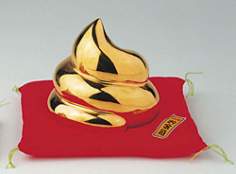Dear Alice,
While browsing through the souvenir shops on a recent layover at Narita Airport, I came across a very curious Japanese good-luck charm. It featured -- I kid you not -- a gold poop which, by the way, looked disturbingly like soft ice cream! Why poop? Why gold poop? Personally, I can't see anything felicitous in feces. Please tell me what the heck I'm missing.
Diane O., Redmond, Washington, USA
Dear Diane,
What you're missing is a pleasing piece of word play. The product you saw is called Kin no Unko (The Golden Poo), a name that plays on the fact that the Japanese word for poop (unko) starts with the same "oon" sound as a completely unrelated word that means "luck." Japanese enjoy this kind of pun -- traditional storytelling is full of them -- which may help explain why more than 2.5 million of the lucky little loads have sold in the last seven years.
I telephoned the company that makes them, Ryukodo, a small Kyoto-based manufacturer of traditional dolls and seasonal display items, and had a friendly chat with Koji Fujii, the company's president, who told me he came up with the idea in late 1999. "Japan was in an economic recession, and the national mood was fairly depressed. I wanted to offer an inexpensive product that would make people smile."
Although they're made of real porcelain and coated with 24-karat gold, Kin no Unko products retail from just 105 yen for a mini poo to 2,100 yen for the big dump, which sits proudly on a silky red cushion. Even so, the line didn't sell well until the spring of 2000, when high-school girls on school trips started snapping them up as silly souvenirs. The kids set off a hit-product boom, complete with news coverage from around the country.
I admit feeling a little disappointed to learn that Kin no Unko is such a recent product. I suppose I had hoped it was a reflection of something deeper in Japanese culture. So on a hunch, I took a sample over to Kokugakuin University in Tokyo, one of just two universities in Japan with a department of Shinto Studies. Professor Takeshi Mitsuhashi looked the product over carefully, nodded thoughtfully, and gave me just the story I had come for.
Mitsuhashi explained that there are many word plays in Japanese religion because puns make information easier to teach and remember. One example is a talisman in the shape of a frog used to pray for the safe return of a loved one, the pun being that the word for frog (kaeru) is a synonym of the verb "to return." "This Golden Poo is very much part of that tradition," Mitsuhashi asserted.
Furthermore, there is a long history of poo-related worship in Japan, according to Mitsuhashi.
"There are more gods in the Shinto religion than it is possible to count, and they reside just about everywhere, inhabiting natural things like trees, rocks and waterfalls," he said. "Bodily functions are very important -- think what a problem it would be if a person couldn't defecate or urinate properly -- so it's natural that people worshipped deities linked to these functions."
The earliest recorded example is a god called Haniyasu, who is mentioned in the Nihon Shoki, an eighth-century text that is one of the most important records of ancient beliefs and practices. Haniyasu is still worshipped at Haruna Jinja, a well-known shrine in Gunma Prefecture. And until fairly recently, it was common to worship deities known collectively as benjo-gami (privy gods) by placing religious figures in or under the privy.
Mitsuhashi, who is in his 60s, remembers his parents burying a pair of god figures, one male and one female, under the privy in his childhood home.
At the risk of getting too graphic, I really must address shape because everyone I spoke to brought it up. Diane, you described the Kin no Unko as looking "disturbing like soft ice cream," while Fujii, its creator, expressed it as a "nice tatsumaki-shape (tornado-shape)."
The difference in perception may lie in toilet types: a Japanese-style toilet consists of a shallow basin built into the floor over which you squat. There's little or no water in the basin until you flush the toilet. So to someone who grew up using Japanese-style toilets, a healthy result would be in the shape of a spiral pile.
Even the professor commented on the shape of the Kin no Unko, praising it as a worthy abode for a god. "Our Shinto gods cannot be seen with the naked eye, but when they are depicted in art, they are always shown as perfection incarnate." He paused and motioned to the golden goofy in front of us. "And that," he proclaimed, "is pretty much the 'Perfect Poo.' It simply doesn't get much better than that!"




